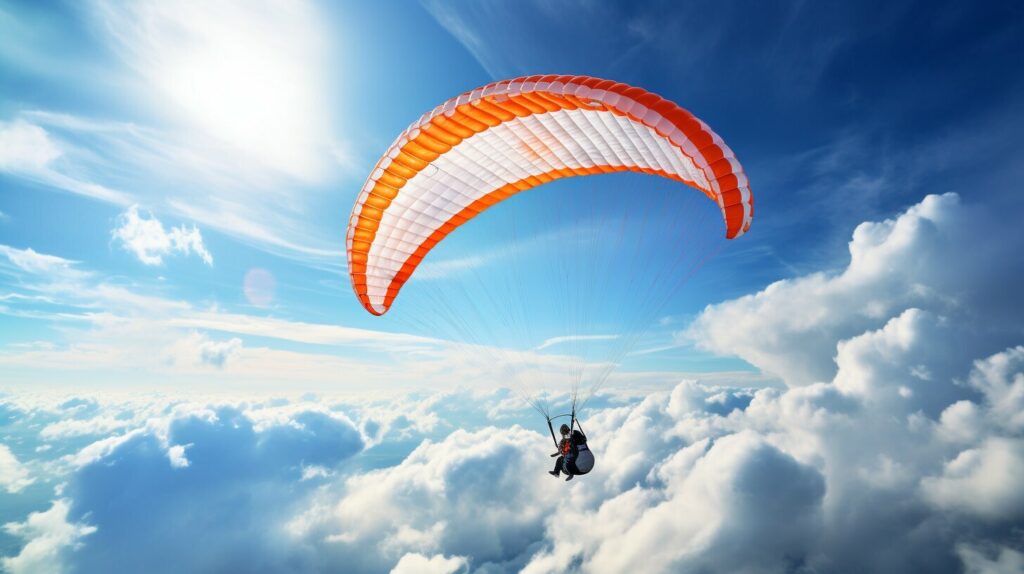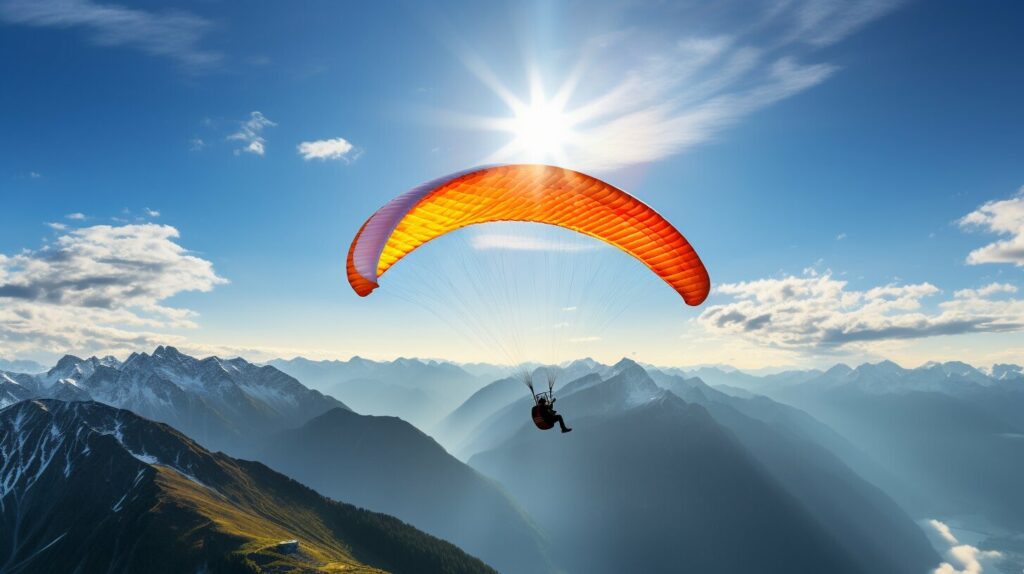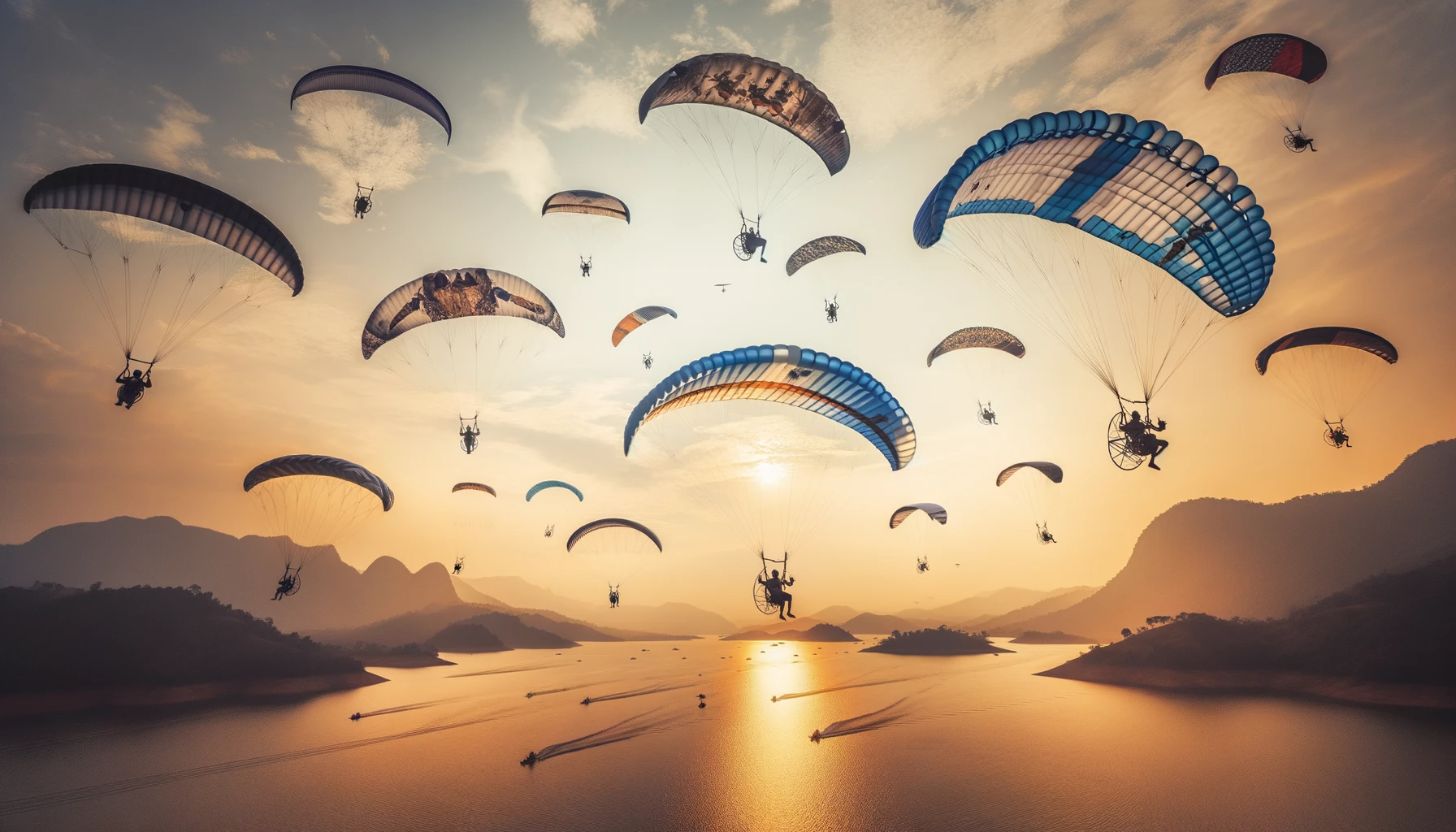If you’re an adventure seeker looking for a thrill in the sky, you might be wondering which aerial sport to try out: paragliding or hang gliding? While both offer unique experiences, there are some key differences to consider before taking flight. In this section, we’ll explore the differences, benefits, and drawbacks of paragliding and hang gliding to help you decide which one is right for you.
Key Takeaways
- Paragliding and hang gliding are two popular aerial sports that offer unique experiences.
- Before deciding which sport to try, consider the differences, benefits, and drawbacks of each.
- Factors such as cost, physical requirements, and the level of challenge you seek should also be considered.
- Ultimately, the choice between paragliding and hang gliding depends on your personal preferences and abilities.
- Whatever you choose, prioritize safety and enjoy the thrill of soaring through the sky.
Paragliding: Soaring with Freedom
Paragliding is a thrilling recreational and competitive sport that allows you to experience the freedom of soaring through the air using a lightweight, free-flying glider. With paragliding, you have the opportunity to fly like a bird, encountering breathtaking views from a new perspective.
One of the benefits of paragliding is that it requires minimal equipment. All you need is a paraglider and a harness, which makes it a more accessible sport compared to hang gliding. Paragliders are typically made of lightweight fabric, making them easy to transport and pack.
Disclosure: When you buy through links on our site, we may earn an affiliate commission.
Besides the feeling of freedom and the simplicity of the equipment, paragliding offers other benefits. It’s a low-impact sport, so it’s less physically demanding than other adventure sports. If you’re looking for a low-stress adventure that still provides an adrenaline rush, paragliding may be the perfect choice for you.
When it comes to equipment, a paraglider comprises three main components; the paraglider canopy, the harness, and the reserve parachute. The paraglider canopy is the fabric wing that you fly, while the harness is the seat that attaches you to it. The reserve parachute is a safety feature that is carried by the pilot in case of emergencies.
Overall, paragliding is a great way to experience the freedom of soaring through the air with a fabric wing. It provides an accessible and low-impact adventure that can be enjoyed by people of all ages, abilities, and fitness levels.

Aerial Adventure with Rigid Wings
Hang gliding is an exhilarating aerial sport that allows you to embrace the wind and soar through the sky. Hang gliders differ from paragliders in that they have rigid wings, which are controlled by shifting body weight. This gives you greater speed and maneuverability in the air.
The advantages of hang gliding are plenty. Not only do you get to experience the thrill of flying, but you also get a great workout for your upper body. The techniques involved in hang gliding are unique and require a certain level of skill and coordination.
Learning to hang glide can be a bit more challenging than paragliding, but the rewards are worth it. You’ll need to master the takeoff, navigation, and landing techniques before you can truly enjoy the sport. However, once you do, you’ll be able to explore new locations and soar to great heights.
If you value speed and agility in the air, then hang gliding is the sport for you.

| Advantages | Techniques |
|---|---|
| Speed | Body weight shifting |
| Maneuverability | Takeoff, navigation, and landing techniques |
| Strong upper body workout |
“Hang gliding allows you to fully embrace the freedom and control of flying, while also challenging your physical abilities.”
Paragliding vs Hang Gliding Safety: Taking Precautions
When it comes to adventure sports like paragliding and hang gliding, safety should always be a top priority. Make sure to take necessary precautions to minimize the risks involved.
Both paragliding and hang gliding involve high-altitude flights and require knowledge of weather conditions, body movements, and equipment handling. Before taking off, ensure you have received adequate training and certifications.
| Paragliding Safety Precautions | Hang Gliding Safety Precautions |
|---|---|
|
|
While both sports have similar safety precautions, they also have their own unique risks. Paragliding, for example, is more prone to turbulence, while hang gliding has a higher risk of collision. It’s important to know what you’re getting into and be prepared accordingly.
Remember that accidents can still happen despite taking precautions, so it’s important to have proper insurance coverage.

Overall, proper training, equipment inspection, and following safety protocols are essential in minimizing the risks involved in paragliding and hang gliding.
Pros and Cons of Paragliding
If you’re considering paragliding as your next adventure sport, it’s important to weigh the pros and cons. Here are some factors to consider:
Pros:
- Accessibility: Paragliding is more accessible than hang gliding with less strenuous physical requirements, making it an ideal choice for enthusiasts of all ages and abilities.
- Easy to learn: Paragliding is generally easier to learn than hang gliding. With proper training and practice, you can be up and flying solo in no time.
- Enjoy the view: With the open-air design of the paraglider, you can fully immerse yourself in the beauty of your surroundings without any obstructions.
- Cost-effective: Paragliding is often more cost-effective than hang gliding, as the equipment is less expensive and doesn’t require as much room for storage.
Cons:
- Less control: With paragliding, you have less control over the direction and speed of flight compared to hang gliding.
- Weather-dependent: Paragliding is highly dependent on weather conditions, which can limit the time and frequency of flights.
- Equipment heavy: While paragliding equipment is generally lighter than hang gliding equipment, it still requires hauling around and keeping track of the glider, harness, and other gear.
Overall, paragliding offers an accessible and enjoyable experience with a lower learning curve than hang gliding, but it may not provide as much control and is weather-dependent.

Paragliding vs Hang Gliding
Both paragliding and hang gliding are thrilling aerial sports that offer a unique perspective on the world. However, as with any activity, there are advantages and disadvantages to each. Here are some pros and cons to consider:
| Paragliding | Hang Gliding |
|---|---|
| Pros: | Pros: |
|
|
| Cons: | Cons: |
|
|
Ultimately, the choice between paragliding and hang gliding depends on your personal preferences and what you want to get out of the experience. Paragliding is a great option for those looking for a more accessible and forgiving sport, while hang gliding offers greater speed and maneuverability for those willing to put in the time to learn. Consider your options carefully and choose the one that best suits you.

Choosing Between Paragliding and Hang Gliding: Personal Considerations
Now that you have learned the differences, benefits, and drawbacks of paragliding and hang gliding, it’s time to consider your personal preferences. There are several factors you should keep in mind before deciding which aerial sport to try.
| Factor | Paragliding | Hang Gliding |
|---|---|---|
| Cost | Paragliding is generally less expensive to learn and participate in, as the equipment is lighter and less expensive. | Hang gliding can be more expensive, as the equipment is more complex and rigid. |
| Physical Requirements | Paragliding requires good fitness and balance, but generally has less strenuous physical demands than hang gliding. | Hang gliding requires more upper body strength and coordination, as well as the ability to run or launch from an elevated platform. |
| Experience | Paragliding offers a more serene and relaxed experience of flying, with longer flight times and a greater range of motion in the air. | Hang gliding offers a more dynamic and thrilling experience, with faster speeds, greater maneuverability, and the ability to perform stunts. |
| Learning Curve | Paragliding has a shorter learning curve and is generally easier to pick up, making it more accessible for beginners. | Hang gliding has a steeper learning curve and requires more instruction and practice to master, but can be more rewarding for experienced pilots. |
Ultimately, your choice between paragliding and hang gliding will depend on your personal preferences, physical abilities, and the level of challenge you seek. Consider trying both sports to see which one you enjoy more and which one suits you better. No matter which sport you choose, remember to prioritize safety and enjoy the thrill of soaring through the sky.

Exploring the Aerial Adventure: Paragliding and Hang Gliding Destinations
If you’re looking for unique and thrilling experiences, paragliding and hang gliding are two aerial sports worth trying. But where are the best locations to try them?
One popular paragliding destination is Interlaken, Switzerland. With its breathtaking views of the Swiss Alps and serene Lake Thun, Interlaken offers an unforgettable experience. Another great spot is Queenstown, New Zealand, where paragliders can enjoy the stunning landscape of the Southern Alps and Lake Wakatipu.

If you prefer hang gliding, the dunes of Kitty Hawk, North Carolina, are a top destination. This location offers the perfect conditions for hang gliding, with consistent winds and a soft landing surface. For a more exotic experience, Rio de Janeiro, Brazil, is a popular destination for hang gliders, offering stunning views of the city and the Atlantic Ocean.
Whether you choose paragliding or hang gliding, there are countless destinations around the world waiting to be explored. Do your research, consider your abilities, and pick a location that will offer the adventure of a lifetime.
Learning and Training: Getting Started
If you’re interested in experiencing the thrilling sensation of paragliding or hang gliding, getting started may seem intimidating at first. However, with the right training and preparation, these aerial sports can be safely enjoyed by anyone.
Firstly, you will need to find a reputable training school or instructor, who can teach you the necessary techniques and safety procedures. They will also advise you on what type of equipment you will need, which will depend on whether you choose paragliding or hang gliding.
| Paragliding Equipment | paraglider wing, harness, reserve parachute, helmet, variometer, GPS device (optional) |
|---|---|
| Hang Gliding Equipment | hang glider, harness, helmet, reserve parachute, altimeter, airspeed indicator |
Before you can start flying on your own, you will need to complete a training course, which typically involves both ground school lessons and supervised flight practice. Your instructor will guide you through the process of learning how to launch, control and land your aircraft, and how to recognize and avoid potential hazards.
Once you have completed your training and obtained any necessary certifications, you will be able to join the community of paragliding or hang gliding enthusiasts and start exploring the skies. Remember, never attempt to fly without proper training and equipment, and always adhere to safety guidelines to ensure a fun and safe experience.
Now that you have a basic idea of what is involved in learning to paraglide or hang glide, it’s time to find a training school and take your first step towards becoming an aerial adventurer!

Conclusion
After exploring the differences and considerations between paragliding and hang gliding, it’s clear that both sports offer unique experiences for thrill-seekers. Ultimately, the choice between paragliding and hang gliding depends on your personal preferences, physical abilities, and the level of challenge you seek. Whichever sport you choose, remember to prioritize safety and enjoy the thrill of soaring through the sky.
FAQ
What is the difference between paragliding and hang gliding?
Paragliding involves flying a lightweight, free-flying glider using a fabric wing and harness, while hang gliding involves flying a maneuverable aircraft called a hang glider with rigid wings and control through shifting body weight.
What are the benefits of paragliding?
Paragliding offers the freedom of soaring through the air, a thrilling experience, and the opportunity to explore scenic locations from a unique perspective.
What equipment do you need for paragliding?
For paragliding, you will need a paraglider wing, harness, helmet, reserve parachute, and other safety equipment recommended by professionals.
What are the advantages of hang gliding?
Hang gliding provides speed, maneuverability, and a more immersive flying experience with its rigid-wing structure and control through body weight shifts.
What techniques are involved in hang gliding?
Hang gliding requires learning techniques such as launching, landing, turning, and controlling the hang glider using weight shifts and body positioning.
How can I ensure safety when paragliding or hang gliding?
Safety is crucial in both sports. It is recommended to undergo proper training, follow safety guidelines, regularly maintain equipment, and be aware of weather conditions and potential risks associated with each activity.
What are the pros and cons of paragliding?
Paragliding offers accessibility, ease of learning, and the ability to soar in various weather conditions. However, it is weather-dependent and requires good judgment for safe flying.
What are the pros and cons of hang gliding?
Hang gliding provides speed, maneuverability, and an exhilarating experience. However, it requires a steeper learning curve and can be more physically demanding than paragliding.
How do I choose between paragliding and hang gliding?
The choice depends on personal preferences, physical abilities, and the level of challenge you seek. Consider factors such as cost, accessibility, learning curve, and overall experience to make an informed decision.
What are some popular paragliding and hang gliding destinations?
There are numerous breathtaking locations around the world for both sports. Some popular destinations include Interlaken in Switzerland, Queenstown in New Zealand, and Oludeniz in Turkey.
How do I get started with paragliding or hang gliding?
To get started, you should undergo proper training offered by certified instructors, obtain necessary certifications, and familiarize yourself with the equipment and safety protocols of your chosen sport.




